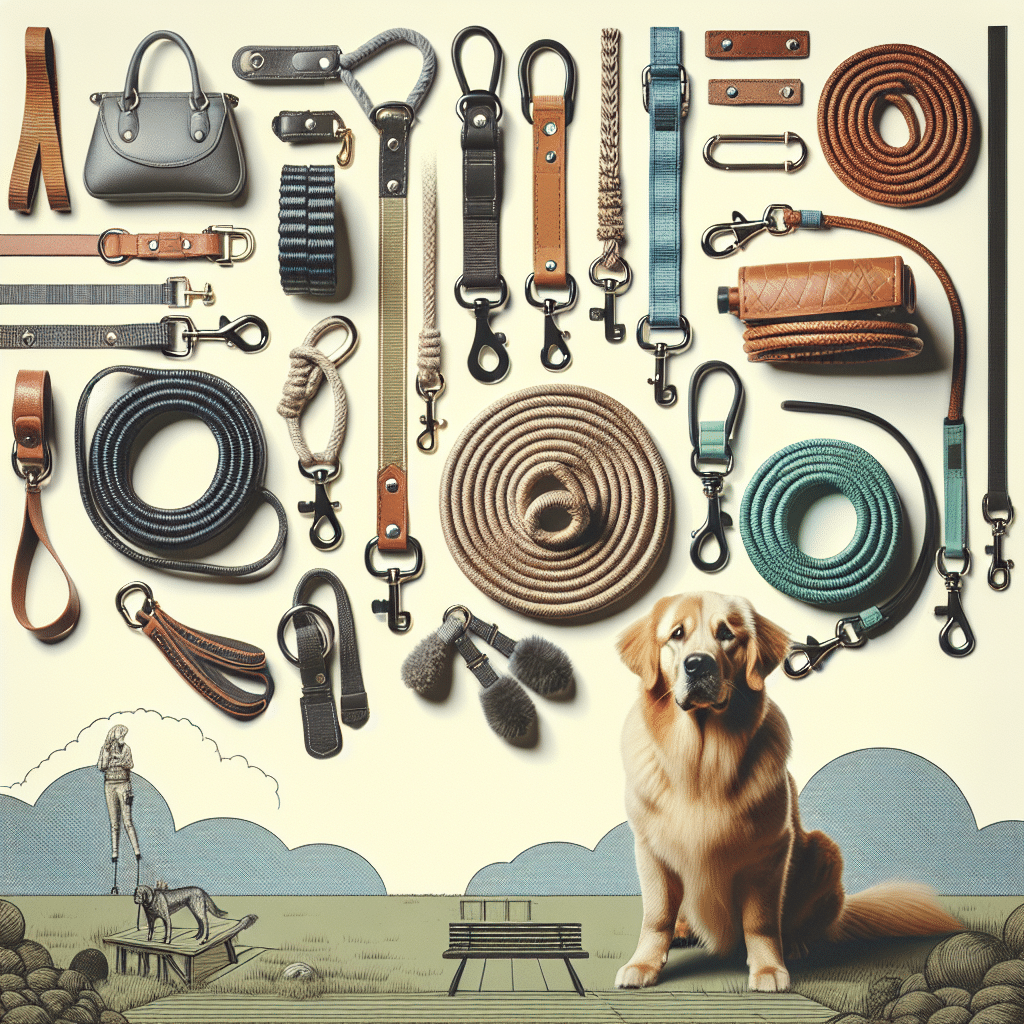Ultimate Guide to Dog Leashes: Materials and Designs
Understanding Dog Leash Components
A dog leash comprises several essential components, primarily the material and design. The material affects durability, comfort, and safety, while the design influences usability and functionality. Selecting the right leash is vital for ensuring a safe, enjoyable walking experience for both dog and owner.
Popular Dog Leash Materials
-
Nylon
- Durability: Nylon is a robust material resistant to wear and tear. It resists fraying, ideal for active dogs.
- Lightweight: Easy to handle, nylon leashes are suitable for small and large breeds alike.
- Variety of Colors/Patterns: Available in a vast array of colors and patterns, nylon leashes allow pet owners to express their style.
- Water Resistance: Though not completely waterproof, nylon usually dries quickly, making it suitable for any weather condition.
- Drawback: It may burn when subjected to prolonged friction. A properly fitted collar reduces this risk.
-
Leather
- Aesthetic Appeal: Leather leashes offer a classic, sophisticated look.
- Strength and Longevity: They are infinitely stronger than nylon and can last years with proper care.
- Comfort: Leather can soften over time, molding to the owner’s grip, which enhances the overall walking experience.
- Natural Material: It does not entail synthetic chemicals, making it a safer option for dogs prone to allergies.
- Drawback: Leather requires maintenance to prevent cracking and drying out.
-
Chain
- Security: Chain leashes are virtually indestructible. Perfect for strong dogs that tend to chew through other materials.
- Weight: Heavier than other options, they provide a sense of security but may not be best for all owners.
- Durability: Rust-resistant versions can withstand any weather, making them suitable for outdoor enthusiasts.
- Drawback: A chain can be uncomfortable for the owner and can dig into the dog’s skin if not managed properly.
-
Biothane
- Waterproof and Durable: Biothane leashes are made from a polyester base covered with a thermoplastic polyurethane. This combination offers durability and waterproof capabilities.
- Easy to Clean: Simply wipe them down, making them great for muddy or wet conditions.
- Versatility: Available in numerous colors and thicknesses, catering to various sizes and styles.
- Drawback: Limited cushioning compared to traditional materials, may be hard for those used to softer leashes.
-
Cotton
- Natural Fiber: Offers excellent comfort and is eco-friendly.
- Soft Texture: Cotton leashes are gentle on the hands and dogs, perfect for less active breeds.
- Variety of Designs: Available in various patterns and colors, cotton can add style to walks.
- Drawback: Less durable than synthetic options and may fray or run if not cared for properly.
Pro-existing Leash Designs
-
Standard Leash
- Length and Width: Typically ranges from 4 to 6 feet long, 1 inch wide, ideal for everyday walks.
- Clip Type: Usually features a sturdy clip to attach to collars or harnesses.
- Usability: Versatile for various dog sizes; great for obedience training.
-
Retractable Leash
- Customization: Allows owners to adjust the length up to 26 feet, giving dogs freedom to explore while still maintaining control.
- Spring Mechanism: Equipped with a spring-loaded mechanism for smooth retraction and extension.
- Safety Features: Many come with locks for controlled leash length.
- Drawback: Retractable leashes may lead to tangling and can snap back if not used correctly.
-
Adjustable Leash
- Multiple Lengths: Features varying length options, often through adjustable clips.
- Versatile Use: Can be converted into a long-line, short leash, or even doubled around the waist for hands-free walking.
- Suitable for Training: Allows flexibility during training sessions with varying distances.
-
Hands-Free Leash
- Waist Straps: Fastens around the waist for an effortless walking experience.
- Ideal for Running: Perfect for active owners who wish to run or jog with their dogs without holding a leash.
- Adjustability: Most models come with adjustable straps for a comfortable fit.
- Drawback: Not ideal for dogs that require strict control.
-
Martingale Leash
- Dual Function: Functions both as a standard leash and anti-pulling collar.
- Gentle Control: Provides gentle correction without choking.
- Ideal for Training: Excellent for dogs that tend to pull, ensuring they remain close while not causing discomfort.
-
Traffic Leash
- Short Length: Typically about 1 to 2 feet long, perfect for crowded spaces and quick control.
- Additional Handle: Features an additional handle near the collar for quick grabs.
- Ideal for Large or Anxious Dogs: Provides better control without giving too much freedom.
-
Multi-Purpose Leashes
- Convertible Designs: Can be adjusted for various uses, including hands-free, shoulder carry, and more.
- Multiple Attachment Points: Allows for different lengths and configurations.
- Great for Multiple Dogs: Enables handling of more than one dog efficiently.
Selecting the Right Leash for Your Dog
When choosing a leash, consider the following:
- Dog Size and Breed: Larger and stronger breeds typically require sturdier materials and designs to withstand pulling.
- Walking Environment: Evaluate where you’ll walk. Urban environments may require shorter, more controlled leashes, while open spaces may benefit from more extended options.
- Comfort Needs: Assess the comfort of both you and your dog. A cushioned handle can be beneficial for long-term use.
- Training Needs: For training purposes, select leashes that provide the support and correction method you prefer.
Maintenance Tips for Dog Leashes
- Regular Cleaning: Depending on the material, clean your leash regularly to prevent grime build-up.
- Inspect for Wear: Check for frays, damage, or broken parts periodically, especially on high-use leashes.
- Store Properly: Store in a dry place away from direct sunlight to prolong the life of your leash.
By understanding the various materials and designs available, you can make an informed decision that best suits your needs and those of your furry companion. Whether you prefer the durability of a sturdy nylon leash or the elegance of a leather option, selecting the right leash is essential for a safe and enjoyable walking experience.
